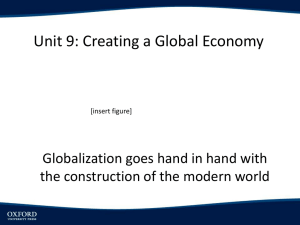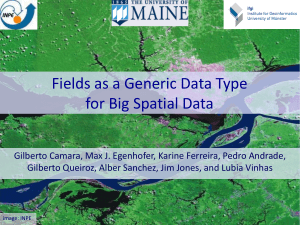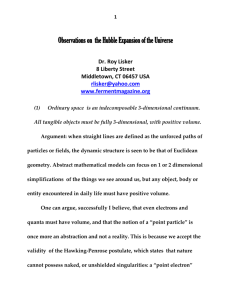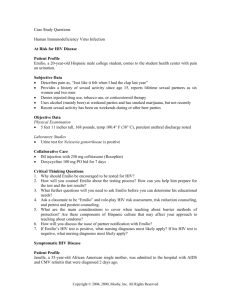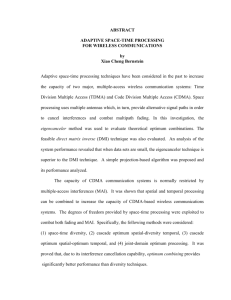View Presentation - University of Southern California
advertisement
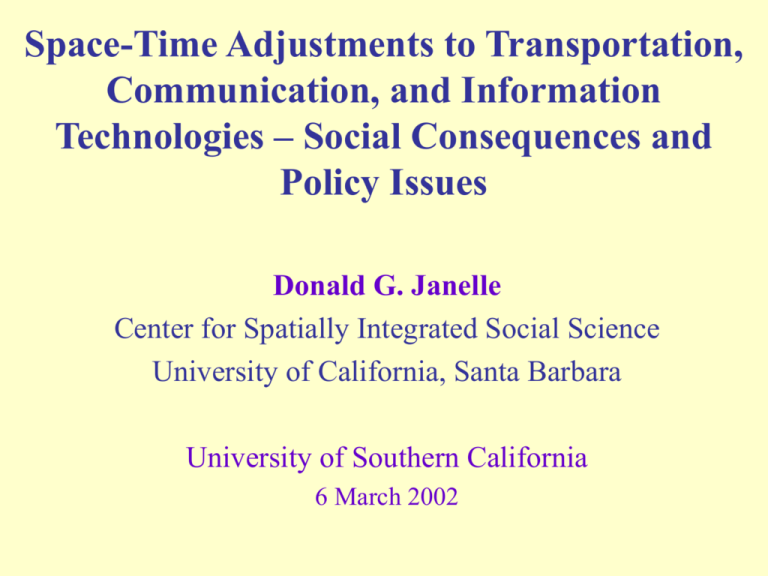
Space-Time Adjustments to Transportation, Communication, and Information Technologies – Social Consequences and Policy Issues Donald G. Janelle Center for Spatially Integrated Social Science University of California, Santa Barbara University of Southern California 6 March 2002 Space Adjusting Technologies transportation systems communication systems wireless communication intelligent transportation systems Location-based Services Information Enhancement via robotic systems expert systems smart cards digital storage media display technologies voice recognition image recognition systems control systems mobile wireless computing . . . and more Adapted by M. van Geenhuizen (2002) from Mitchell (1999) Space-Time Transformations Time-space Convergence Time-space Compression Human Space-time Extensibility Trackability and LBS Los Angeles Santa Barbara 500 minutes apart in 1901 100 minutes apart in 2001 Time-Space Convergence: 400 minutes Average Rate of Convergence: 4 minutes per year “velocity” Problems of Travel Time as a Metric of Space: • Variability in convergence and divergence among places • Time-space inversions • Asymmetric relationships between places • Simultaneity of different convergence / divergence levels – by social class / transport mode Avg TSC 26 min/yr Janelle 1968 Time-Space Convergence Metropolitan Expansion • • • • Morphologies of Cities Topologically Equivalent Locations TSC and Susceptible Land Supply Behavioral Responses to TSC – the Quest for Amenity Janelle 1995 Pre 1957 1961-1965 1976-1980 Convergence Rates for Metropolitan Settings Topologically Equivalent Locations City Center - a b,c,d,e - Beltway f,g,h,i - Ends Janelle 1995 Average Travel Time (minutes) each place to all 8 other places 1960 1980 Convergence Rates 1960-1980 Average minutes per year, each place to all 8 other places using shortest time paths 33.2 49.3 62.4 27.5 25.5 34.3 0.29 1.19 1.4 Travel Speeds and Accessible Land Resources from Urban Center Average Travel Speed (Km/hr) Average Daily Commuter Trip (1way minutes) Potential Distance from City Center (km) Land Resource (Sq Km) 60 30 30 2827 70 30 35 3848 80 30 40 5027 80 50 67 14103 Janelle 1999 Janelle 1995 Adapted from Guert Hupkes 1982 Janelle 1995 Time-space Compression • David Harvey – 1989 The Condition of Post Modernity – 2001 Spaces of Capital • Experiential – pace of life / escalation of events • ‘Annihilation of space by time’ (Marx) – Links to capital accumulation process – speeding up production, exchange, circulation, consumption Human Space-time Extensibility • ‘Measuring human extensibility in a shrinking world’ (Janelle 1973) – The reciprocal of time-space convergence – Interaction beyond one’s immediate physical presence – Projection of authority and of one’s presence over space and time • Parallels with Anthony Giddens’ ‘time-space distanciation’ (1981, 1984) – Stretching social systems across space and time Recent Research Human Space-time Extensibility • Paul Adams ‘A reconsideration of personal boundaries in space-time’ (1995); ‘CAD-based accessibility model’ (2000) – – – – People as branching structures The extensibility diagram Linking micro and macro scales – the role of IT Using CAD with data collected though personal interviews and detailed records of communication activities Diann’s extensibility for a typical Thursday, autumn 1997 Paul Adams (2000) Extensibility diagram linking Diann’s communications with survey participants Paul Adams (2000) Paul Adams 1999, Bringing globalization home: A homeworker in the Information Age Recent Research Human Space-time Extensibility • Mei-Po Kwan ‘Human extensibility and individual hybrid-accessibility’ (2000) – Cartographic visualization of interaction in cyberspace and physical space – Extensibility diagram as analytic tool within 3D GIS using data from Web browser logs and personal interviews Mei-Po Kwan 2000 ‘Human extensibility and individual hyprid-accessibility in space-time: A multiscale representation using GIS Multi-scale Extensibility diagram 3D GIS using data from Web browser logs and personal interviews Mei-Po Kwan 2000 Trackability • Consensual – Space-time activity diaries – Travel surveys • Indirect surveillance – Zip code matching of Credit card expenditure patterns (M.J. Weiss, The Clustering of America; O.H. Gandy Jr. The Panoptic Sort) • Direct real-time surveillance – Cameras, mobile phone, GPS, telemetry An individual’s path in timespace coordinate system -- after Hägerstrand From B. Lenntorp 1978 Mei-Po Kwan, 2002 – GIS-base 3D geovisualization of space-time paths of African and Asian Americans. Data from Portland OR activity surveys The Time Geography of a Canadian City Project • DOMA (Dimensions of Metropolitan Activity) study of Halifax Canada Space-time budget surveys and analyses (Andrew Harvey 1971-72). – Approx 2100 one-day diaries spread over the week / – 99 activity types (Multinational Time Budget Study, Szalai 1972) – space-time coded to a resolution 1-minute in time and 100 meters in space • Time Geography of a Canadian City Project (Janelle & Goodchild) – Reconstructing “census-like” data for any time of day – Factorial ecology based on activity data instead of census data (who is where when? What are they doing and with whom?) • PARAFAC 3-mode solution (activities, space, and time) – What is the link between individual behavior and urban ecological structure? •Janelle & Goodchild, Economic Geog (1983), Urban Geog (1983) •Goodchild & Janelle, Environment & Planning A (1984) •Goodchild, Klinkenberg, & Janelle, Geographical Analysis (1993) •Janelle, Klinkenberg, & Goodchild, Geographical Systems (1997) Aggregating individual travel data by sub-populations Role-group correlations in space by time of day (for selected hours) .50 Home owners-Renters .30 Employed-Unemployed Female-Male Midnight Midnight Index of Spatial Dissimilarity between subpopulations by time of day Location Quotients – Concentration of Unmarried Respondents by time of day Space-time Ecology of Human Activity in Halifax Dominant Activity Patterns By Time of Day Location Based Services • An LBS “. . . is an information service that exploits the ability of technology to know where it is, and to modify the information it presents accordingly” (MF Goodchild). [E.g., wireless GPS in real-time navigation] • The Global Positioning System and cellular technologies enable new devices that know where they are, and are capable of modifying the information they collect and present based on that knowledge. • The U.S. Wireless Communication and Public Safety Act (1999) permits operators of cellular networks to release geographic locations of users in emergency situations. [Tracking devices are now required in cell phones sold in the U.S.] • New electronic services are being developed / offered to find locations, compute routes, identify nearby businesses and other facilities, notify of proximal events, report and find a stolen vehicle, Mayday alert, etc. Nokia prognosis for 3G mobile communication Monthly income pr. user in euro (1 euro = 1 USD ca.) 100 Location based services 90 Div. telecomm. 80 Commercials Text messages Entertainment 70 Information services Payment transactions Music and video Internet surfing Download from internet Chat on internet Multimedia messages Photo messages 60 50 40 Vide conferencing 30 20 Normal speech 10 Fixed subscription fees 0 2000 2001 2002 2003 2004 2005 2006 2007 2008 2009 2010 2011 Cell Phone / PDA – Initial LBS client base From T J Kim Location Service Concepts The – – – – – – – – Device – – – – – Cell phone Palm top Lap-top Kiosk Car-based computer Cell antenna Mobile device Display Actors The Location Point and Reference Segmented Line Address Route Descriptive Directions – Gazetteer – Direction – Polygon Payload From T. John Kim, 2002 Items The Service – – – – – – – – Routing Avoiding Traffic Tourism Regional Attractions Event Handling Maps and Backdrops Guidance Preference Service Providers Issues Regarding LBS Use of LBS to support primary data capture in space and time -- by whom, for what purpose, and why? What new industries will emerge from LBS, and where? [E.g., new tools for visualization and analysis] What new forms of social / economic behavior are enabled? [Will surveillance uses undermine some current activity patterns or allow others?] What will be the implications of such behavior on regional development and on the social capital of places? Privacy, ethical, and security issues? Is this an instance of ‘radical technology’? See www.csiss.org/events/meetings/location-based/ Social Science Research Challenges? • Determine the extent to which mobility (the consumption of distance) is intrinsic to human society • Conceptualize, measure, and model the social and cultural context of ICT and transport innovation -- e.g., accessibility, equity • Document and interpret behavioral responses to new space-adjusting technologies • Seek to understand how these behavioral responses impact on patterns and processes of regional and local space economies, equity, social cohesion, quality of life, and sustainable environments – and related structural changes in societies and economies • Seek to understand how new technologies are socially constructed and embedded in the distribution of authority, power, and opportunity – e.g., what is LBS in terms of how it is socially constructed? • Explore challenges arising to the dominant paradigms: – Questioning the Desirability of Mobility – Exploring possible benefits of space-time divergence, and space-time decompression – Providing personal autonomy over when and where to be tracked Policy Issues and Measures • Facilitating constructive uses of new information and communication technologies to enhance accessibility • Protecting/respecting individual autonomy over personal information and behavior • Protecting/respecting a minimum basic economic and cultural autonomy for places, regions, and nations • Protecting vulnerable environments and populations from destructive uses of new technologies Thank you

